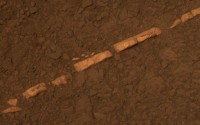Research: simulating Mars on Earth

Derek Martin of the School's Physics of Living Matter group explains his work.
My background is in geomicrobiology. I have previously been involved in designing and building equipment for retrieving and sub-sampling deep sea sediment cores whilst retaining in situ pressure. This allows us to be able to manipulate sediments under anaerobic conditions at pressures of up to 1000 times atmospheric pressure.
Sub-surface microbes can be enriched, isolated and characterised without exposing them to atmospheric pressure at any point, giving us the means to attempt to isolate novel piezophiles (microbes requiring increased pressure to grow) and assess the role of microbes in biogeochemical cycles in the sub-surface.
Other areas of my research include investigating the microbial mediation of mineral precipitation; in particular, looking at the ability of bacteria to precipitate carbonates under pressure and their possible use for subsurface engineering in the context of carbon capture and storage.
Planetary simulation chamber
My work at Edinburgh will be to develop and build a planetary simulation chamber to allow us to manipulate the environmental conditions of microbial and geochemical experiments. The purpose of these experiments is to understand the potential for life beyond Earth and to gain insights into microbial physiology.
Initially this work will focus on replicating the conditions on Mars: low temperature, low pressure and high ultraviolet light flux. The intention is to be able to flow relevant fluids through the simulator and investigate the conditions under which microbes will grow, including their interaction with the rock substrate as a possible source of energy.
I will be looking at the possible composition of Mars fluids and whether the conditions have any analogues on Earth, which could help us understand whether life on Mars is possible now, or has been in the past. The intention is to extend these types of studies to the conditions present in the deep sub-surface to help us understand the role of microbes in this environment and the implications for astrobiology. It will also help us understand biogeochemical cycling in the terrestrial subsurface of Earth in the past and present, and also potentially in the future.
About the Physics of Living Matter group
The group's research in this area spans many length and time scales: from aqueous solutions of small bioactive molecules through proteins and DNA to single cells, cell-cell interactions, and collection of organisms in ecosystems, studying phenomena occurring at picoseconds to decades. It uses all three methodologies of physics: experiment, simulation and theory.

